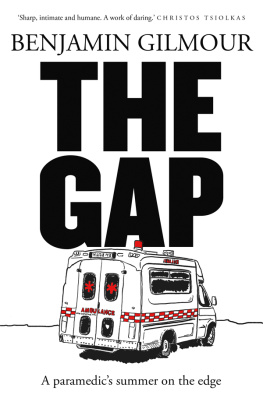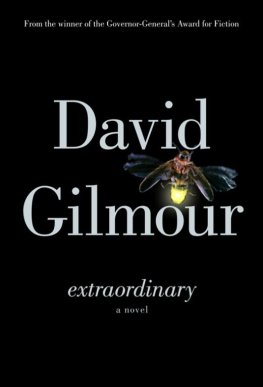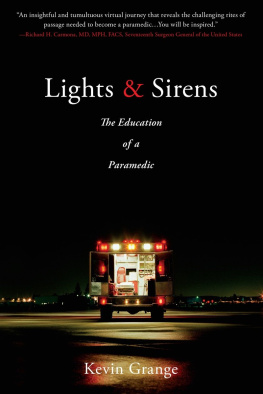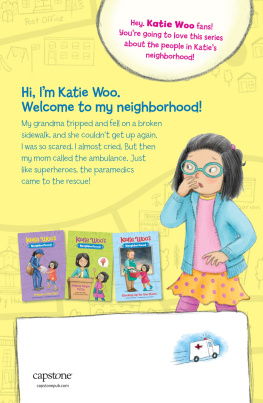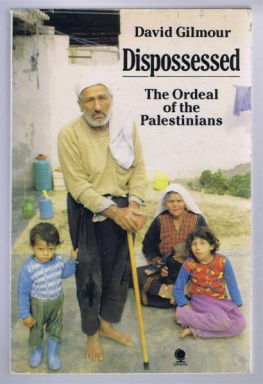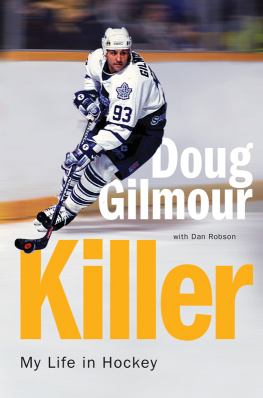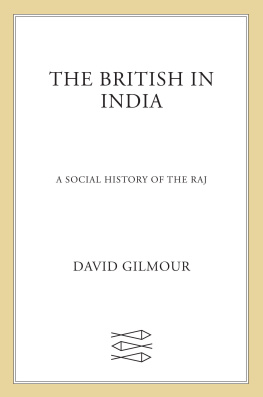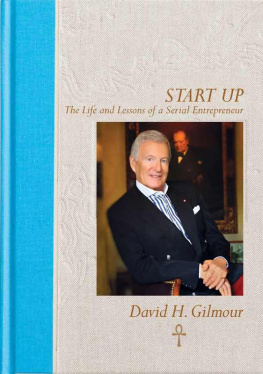Benjamin Gilmour - The Gap: A paramedic’s summer on the edge
Here you can read online Benjamin Gilmour - The Gap: A paramedic’s summer on the edge full text of the book (entire story) in english for free. Download pdf and epub, get meaning, cover and reviews about this ebook. year: 2019, publisher: Penguin Random House Australia, genre: Detective and thriller. Description of the work, (preface) as well as reviews are available. Best literature library LitArk.com created for fans of good reading and offers a wide selection of genres:
Romance novel
Science fiction
Adventure
Detective
Science
History
Home and family
Prose
Art
Politics
Computer
Non-fiction
Religion
Business
Children
Humor
Choose a favorite category and find really read worthwhile books. Enjoy immersion in the world of imagination, feel the emotions of the characters or learn something new for yourself, make an fascinating discovery.
- Book:The Gap: A paramedic’s summer on the edge
- Author:
- Publisher:Penguin Random House Australia
- Genre:
- Year:2019
- Rating:4 / 5
- Favourites:Add to favourites
- Your mark:
- 80
- 1
- 2
- 3
- 4
- 5
The Gap: A paramedic’s summer on the edge: summary, description and annotation
We offer to read an annotation, description, summary or preface (depends on what the author of the book "The Gap: A paramedic’s summer on the edge" wrote himself). If you haven't found the necessary information about the book — write in the comments, we will try to find it.
The Gap: A paramedic’s summer on the edge — read online for free the complete book (whole text) full work
Below is the text of the book, divided by pages. System saving the place of the last page read, allows you to conveniently read the book "The Gap: A paramedic’s summer on the edge" online for free, without having to search again every time where you left off. Put a bookmark, and you can go to the page where you finished reading at any time.
Font size:
Interval:
Bookmark:

Benjamin Gilmour has been a paramedic for more than twenty years. He has seen his fair share of drama. But the summer of 2008 remains etched in his memory for the very worst reasons.
In this riveting memoir, Gilmour recounts the call-outs that summer: some dangerous, some gruesome, some downright ridiculous. And we meet fellow paramedic John who, they say, can get a laugh out of everyone except the dead. As the city heats up, however, even John begins to lose his sense of humour. People are unravelling and Benjamin and John are no exception.
The Gap is a vivid portrait of the lead-up to Christmas; an unflinching, no-holds-barred look at what happens after the triple-zero call is made the drugs, nightclubs, brothels, drunk rich kids, billionaires, domestic disputes, the elderly, emergency births, even a kidnapping. Patients share their innermost feelings, and we witness their loneliness, their despair and their hopes.
Beautifully written and sharply observed, The Gap exposes the fragility of our lives and the lengths that paramedics will go to try to save us.


This book has been written from detailed notes I took while working as a paramedic on ambulances in Sydney during the summer of 200708. An early draft was finished in 2009, but I considered the material too sensitive to publish at the time. Ten years on, enough has changed to allow for the story to be told.
Although this book narrates true events, the names and ages of patients have been altered, as have locations, times and other identifying features, to protect their privacy. The names of my fellow paramedics have also been disguised, with the exception of my friend John, and in some cases the characteristics of two or more colleagues have intentionally been merged to further respect their wish for anonymity. For narrative purposes, there are instances where the order of some events has been shifted. Conversations are either recorded word for word based on my notes, or roughly as I remember them.
All views expressed in this book are mine alone and do not represent those of other paramedics or my employer. Nor does my attitude and conduct in this book necessarily reflect the person and paramedic I am today, ten years later, or the attitude and conduct of my colleagues in the present. I no longer work in Sydney, and every main player in this book has moved on too. But what will never change is the trauma and death paramedics are exposed to, and the impact this can have on us and the way we manage our mental health.
While there are many external factors that affect paramedics wellbeing beyond the influence of an employer, since writing this book a decade ago remarkable work has been done by ambulance services in Australia to address the emotional and psychological needs of staff. NSW Ambulance, for example, has hired full-time psychologists, expanded their chaplaincy and peer support programs and conducted wellness workshops. While organisational change can be complex and slow, the shift in workplace culture and the generous funding and strategies implemented to improve paramedic wellbeing should be acknowledged.
A word of warning: there are moments of black comedy in this book that some readers may find confronting. But an authentic narrative of this kind cannot exist without the gallows humour that paramedics are famous for, a humour shared by many doctors and nurses, police and undertakers. Studies have shown that this type of humour has an important psychological and social function in professions that deal with pain and sorrow on a daily basis. Its a way of slaying the monster, of dealing with stress and keeping up morale.
There is also frank discussion of mental illness and suicide. The manuscript has been assessed by psychologists at Everymind for impact on vulnerable readers, and dozens of changes have been made to soften imagery and remove explicit detail. Even so, if you feel triggered while reading, please reach out, make a call and ask for help. A list of excellent crisis support services that can assist you are included in the back of the book.
Lastly, since writing about some of my experiences with poor survival rates of cardiac arrest, Ive been involved in more than half a dozen saves. Increased community CPR and access to defibrillators, along with improved paramedic resuscitation techniques, have played a part in this.
Special thanks goes to my former colleagues, both paramedics and nurses, for their ongoing friendship and reading of the manuscript; to my brilliant publisher Sophie Ambrose, editor Tom Langshaw and agent James Wills; to psychologist Sara Bartlett and the suicide prevention team at Everymind; to the Dixon family, Antony Loewenstein, John Zubrzycki, Tony Ayres, Craig Henderson, Marele Day and Alex Warner; and to my parents and my ever-supportive wife, Kaspia.
Benjamin Gilmour
August 2019
At the highest point of The Gap, where the clifftop rises like a tower, it is ninety metres to the sea. Tourists and daytrippers come in groups to stand at the wood-and-wire fence, inhaling the sunrise. They chatter about nothing of consequence, but are quickly made speechless by natures might. Ive seen them stand like people at a crossroads, suddenly conscious of their smallness. The Gap is a place of great change, new journeys, different paths. But for others who come, their hope is long lost. To them, The Gap is a backdrop for the final act of life. Its the edge of the world from which they leave. Fifty or more go over each year, from the top, or further around where the fence is easier to scale. They do it at dawn, in the heaviest rain, and on the quietest of nights.
For us local paramedics the beauty up here is hard to admire.
Were called to a woman in her twenties whos been seen climbing the fence. I slow the ambulance and turn around, head back that way.
How inconsiderate, says John, my paramedic partner. Killing herself so close to our knock-off time.
Hes the king of dark humour, our John. It diffuses frustrations, lightens a little the tragedies we see, and helps us to get through each shift.
Least weve come well prepared. John opens the glovebox and pulls out a packet of peanuts.
Ever nibbled Nobbys Nuts?
Standing by at suicide attempts can lead to awful hunger. Some suicidal patients will hesitate for hours. For paramedics the tedium of the wait is bad enough, but the hunger is worse. Emergency nuts have long been the answer.
Patients who are still on the edge when we get to the scene dont often follow through. Many others have fallen before we manage to get there. Sometimes we see their bodies on the rocks or in the water. If the chopper or rescue squad dont reach them in time, they can disappear forever.
Just past the little row of shops at Watsons Bay a police officer waves us down. He approaches and says the girl cant be found. He thinks she must have gone over. Her sneakers were neatly placed at the edge. Why people leave their shoes is anyones guess. Perhaps to not drag any dirt from this world into the next.
We park the ambulance behind the girls blue hatchback and see a man must be her father cross the road. John opens the bag of salted peanuts, throws a few into his mouth. He crunches down, then passes the packet over.
Font size:
Interval:
Bookmark:
Similar books «The Gap: A paramedic’s summer on the edge»
Look at similar books to The Gap: A paramedic’s summer on the edge. We have selected literature similar in name and meaning in the hope of providing readers with more options to find new, interesting, not yet read works.
Discussion, reviews of the book The Gap: A paramedic’s summer on the edge and just readers' own opinions. Leave your comments, write what you think about the work, its meaning or the main characters. Specify what exactly you liked and what you didn't like, and why you think so.

